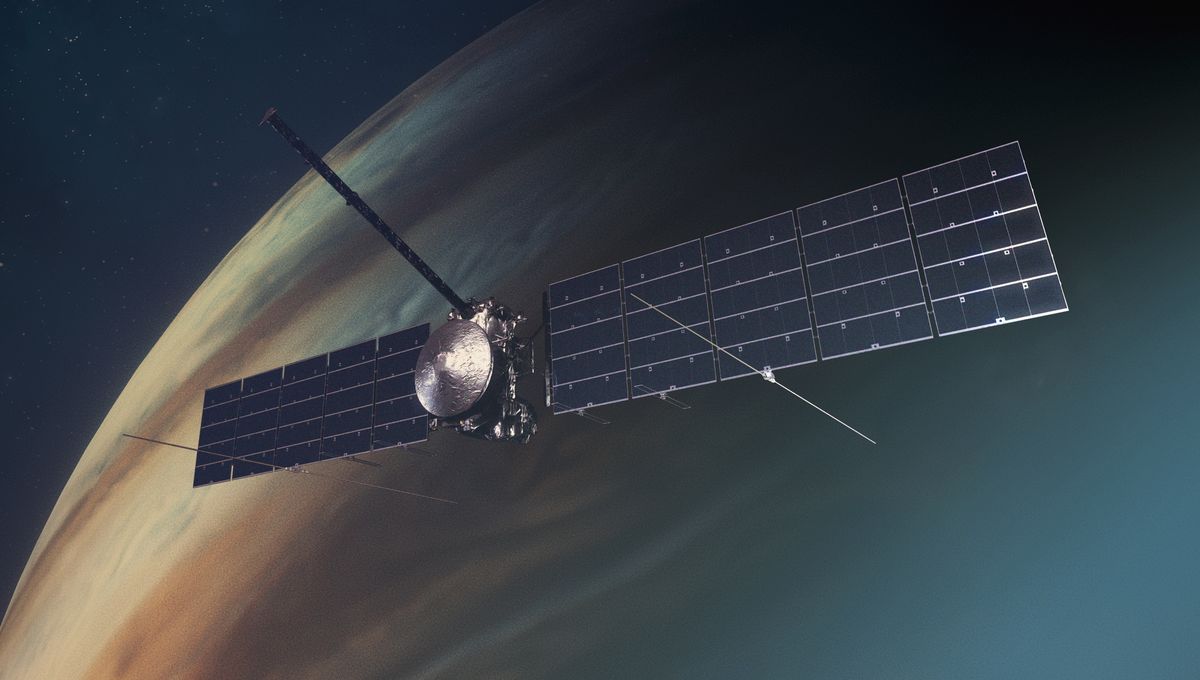
On Monday, the Europa Clipper blasted off on its quest to study the smallest of Jupiter’s big four moons, and hopefully collect clues about the prospect of life inside. The launch was delayed four days by Hurricane Milton, but that wait is insignificant compared to the five and a half years it will be before the Clipper inserts itself into orbit around Jupiter. Even after that, it will be a year before it gets close enough to Europa to begin its primary task. At its closest, Jupiter is around seven times as far away as Mars, and our missions get there in about six months, so why is this mission so slow?
The Europa Clipper is NASA’s largest planetary mission spacecraft, largely to shield itself from the charged particles accelerated by Jupiter’s powerful magnetic field. Propellant aside, the Europa Clipper is 3,241 kilograms (7,145 pounds), whereas the Voyagers, which took 18 and 23 months respectively to reach their closest approach to Jupiter, have just a quarter the weight in the same gravitational field. However, it’s not the need to move all that extra mass that is the reason the Europa Clipper will take so much longer to reach its target. For one thing, it carries a great deal more fuel, so if it was on the same journey as the Voyagers, it would have no trouble keeping up.
One clue to the difference in timing is the Clipper’s intended path. Rather than setting a direct course for the largest planet, it will instead head towards Mars, where it will undergo what is known as a gravity assist, where a spacecraft steals a little bit of a planet’s orbital velocity to increase its own. The ratio in mass between the two objects is so immense that the effect on the planet’s velocity is unnoticeable with existing instruments, but it’s a different matter for the probe.
Visiting Mars doesn’t sound like a big deviation – after all Mars passes between Earth and Jupiter – but instead of pushing outwards, the Clipper will zoom back towards Earth. Having apparently got absolutely nowhere on the first half of its trip, the Clipper will perform another adjustment and use Earth’s gravity to accelerate it towards its final destination.
This looping means the total journey to Jupiter will be 2.9 billion kilometers (1.8 billion miles), or almost 20 times the distance between the Earth and Sun. Considering that at its closest, Jupiter is just 590 million kilometers (365 million miles) away, and never gets more than a billion kilometers from us, the Clipper is definitely taking the long way round.
Or perhaps we should say a long way round, because even this route is short compared to the Clipper’s companion, JUICE, which launched in April 2023 and won’t get to Jupiter until well after the Clipper.
Picking up some extra speed through the gravity assists makes these journeys quicker, but certainly not as quick as going there directly on launch speed alone.
So why do it this way?
The main difference between missions like the Europa Clipper, JUICE, and JUNO on the one hand, and the Voyagers on the other, is whether the intent is to stay or to pass right by. If you’re paying a quick visit (or planning to crash into either Jupiter or a moon), your speed doesn’t matter much. However, to get into orbit, a spacecraft needs to end up circling the Sun at the same rate as Jupiter does.
Jupiter’s powerful gravity can be used to adjust an incoming spacecraft’s motion, and space probes can adjust their own speed with their rockets. However, unless you’re planning to use vast amounts of propellant, raising the launch mass even further, the orbital velocity on approach needs to be quite close to Jupiter’s.
The reason we can put missions into orbit around Mars and Venus, or even land on their surfaces, relatively quickly, isn’t so much that those planets come closer to us. It’s that they orbit the Sun at velocities not all that different from the Earth’s. When we launch a spacecraft it starts off orbiting the Sun at the same rate as the Earth, with a small adjustment for the push provided by the launch rocket. To vary that velocity until it matches that of our nearest neighbors is not that hard, but Jupiter is a different matter.
The orbital velocity of the other gas giants is even more different from Earth’s, which is why missions there are harder still. The Cassini spacecraft’s launch mass involved more propellant than payload, structure, and shielding combined.
JUICE needed to take an even longer route so it could get more gravitational assists (including an unprecedented one using the Earth and Moon together) because it was launched on an Ariane 5 rocket. This gave it less of a boost than the Falcon Heavy used to launch the Clipper. Perhaps it was appropriate a sloth photobombed the launch. Earlier plans for the Clipper intended it to be launched with NASA’s Space Launch System (SLS), which could have provided enough momentum to head for Jupiter directly, but the SLS was considered too untried.
All of this explains why, despite the enormous scientific importance of a mission to Uranus or Neptune, nothing is scheduled – it’s hard to get funding for something that would take decades to get there. The problem has even inspired some radical (and risky) ideas for a more direct path to Neptune that still ends up in orbit.
Source Link: Why Does It Take So Long To Get To Jupiter's Moon, Europa?